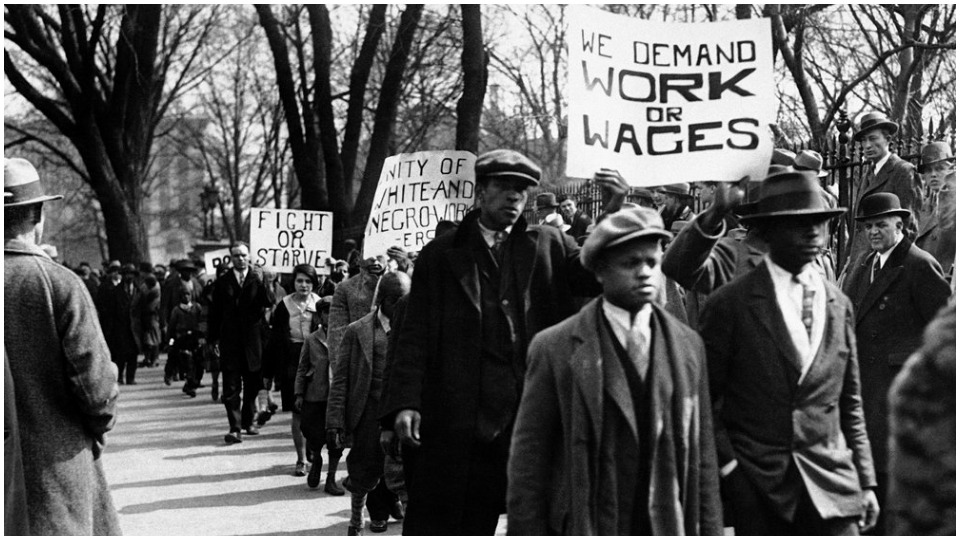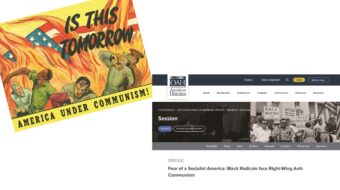
This is part one of a two-part article on the Communist Party USA in the 1930s.
Many of the struggles in which Communists had played a leading role in the 1920s had ended in defeat. The 1926 Patterson, New Jersey, silk strike and the Gastonia, North Carolina, mill strike had been crushed. Sacco and Vanzetti died in the electric chair in 1927.
But Communists, strengthened by both the world movement of which they were a part and a political structure that united them, kept on coming and learning from the defeats.
Many working people on factories and farms—as well as professional people, journalists, teachers, writers, and artists—who had participated in these struggles learned to respect Communists for both their words and their deeds, for their courage and commitment.
Although capitalist media, following the lead of Secretary of Commerce and later President Herbert Hoover, had proclaimed the 1920s “a new era” of permanent prosperity where corporations would de-emphasize short term profits to produce better and cheaper products, workers would “democratize” capitalism by owning stocks and bonds, and the small number of poor would be generously cared for by private charity, this capitalist utopia collapsed in the great stock market crash of October 1929.
Over the next four years, unemployment rose to more than a third of the workforce (by labor movement figures), wages for the employed were slashed, and 25 percent of all people with bank accounts lost their savings.
2019 marks a century since the founding of the Communist Party USA. To commemorate the anniversary of the oldest socialist organization in the United States, People’s World has launched the article series: 100 Years of the Communist Party USA. Read the other articles published in the series and check out the guidelines about how to submit your own contribution.
Capitalists identify progress with individual initiative and the ability to take advantage of changing situations in a clear-headed way, avoiding both panic and inaction. Communists and the CPUSA leadership took collective initiative to fight the Depression while the capitalist class was both panicking and calling upon government to do nothing and let the “free market” restore prosperity.
Capitalist predictions that the Depression would be over in weeks turned into months, and months into years.
Rallying the unemployed
In March 1930, Communists in the U.S. and around the world organized “International Unemployment Day” (on what was also both International Women’s Day and the 13th anniversary of the beginning of the Russian Revolution) to mobilize against the crisis. The demonstrations in the U.S. drew tens of thousands, surprising both their organizers and the capitalist power structure.
After the demonstrations, it became harder for the press to deny what was happening, and news reports on what was now called “the Great Depression” became common.
Unemployed Councils, USA, led by Communist Herbert Benjamin, organized in cities across the country to block the evictions of tens of thousands of tenants who could not pay their rent, demanding work relief (public jobs for the unemployed) and home relief (aid for those who could not work, particularly women with dependent children and the disabled).In rural areas, Communists also joined with other groups in fighting against farm foreclosures.
The Unemployed Councils came forward with a new idea—Unemployment Insurance. The concept was so identified with the Communist Party that the then-conservative American Federation of Labor, in voting the proposal down in 1932, condemned it as a “Communistic program.”
A rarity for the time, even in progressive circles, the Councils were racially integrated, often sending groups of Black and white activists together to resist the evictions of both Black and white families from their homes.
In 1935, the New Deal government of Franklin Roosevelt, elected three years earlier at the height of the Depression, would enact unemployment insurance, along with the most comprehensive public works, labor, and social welfare legislation—including collective bargaining, old age pensions under Social Security, minimum wages, and the 40-hour week. Together, they represented the most important victories for workers in U.S. history.
Roosevelt would define these policies as an attempt to both reform, humanize, and save the capitalist system. W.E.B. Dubois would later say that they represented a surge in the direction of socialism. In a sense, both were correct.
While the benefits were less than the CPUSA and others advocated, both the leading role of the Communist Party in the Unemployed Councils as well as union and community organizing made policies that were considered impossible in 1929 realities less than a decade later.
Black and white—Unite and fight!
In 1931, nine Black teenagers were arrested for on charges they had raped two white girls on a train near Scottsboro, Alabama. They were almost lynched, paraded through a show trial where their “attorneys” told them they were on their own, and were quickly sentenced to death.
The International Labor Defense, a project initiated by the Communist Party, took on the case when other groups would not and employed distinguished appeals lawyers twice to win retrials for the Nine, saving their lives.
For the segregationist power structure, executing the Scottsboro Nine was essential to their definition of “freedom” and the “American way of life.” To Communists and those who joined in the struggle to save the Nine, their lives mattered as much as the lives of any American, and their deaths would be a major blow to the struggle to make freedom and democracy real for all.

The ILD and the global Communist movement led demonstrations around the world to mobilize support for the Scottsboro Nine. Although there was no quick happy ending—the case dragged on through a number of trials and compromises—most of the Nine were eventually freed and no one was executed.
For the first time since the 1850s when the international abolitionist movement brought the horrors of slavery in the U.S. to international audiences with the stories of runaway slaves and free Black victims of the Fugitive Slave Act, an important example of racist oppression in the United States reached a global audience. Two young African-American people, NAACP members, in Montgomery, Alabama—Rosa Parks and her husband Raymond—were also drawn into the fight as the ILD’s militancy brought the NAACP and the ACLU into the struggle. Mrs. Parks would be heard from again during the Civil Rights Movement of the 1950s.
As the New Deal government advanced labor and social welfare reforms in response to the working-class upsurge, Communists led in the formation of a new civil rights group—the National Negro Congress. The Congress sought to build alliances with and through the new industrial unions organized under the CIO to influence the Works Progress Administration (WPA) to advance the interests of African-Americans in the fight for full political and social equality.
This took the form of campaigns for a national anti-lynching law, an end to “legal” segregation and disenfranchisement in the South, and for the elimination of racist policies and practices throughout society. Communists also played a leading role in the development of the Southern Negro Youth Congress, which fought grassroots battles to advance the struggles against segregation and racism.
Although these and other militant civil rights organizations which Communists helped to build would be ruthlessly suppressed in the Cold War following WWII, many veterans of these struggles would play important roles in the victories won during the great civil rights upsurge of the 1950s and ’60s, just as many veterans of the campaigns which had ended in defeat in the 1920s would play important roles in the victories won during the great labor upsurge of the 1930s.
Building workers’ power
Communist Party activists had struggled to build inclusive industrial unions since the birth of the party. In 1934, a series of strikes by working people influenced by the lessons of earlier struggles and the hopes raised by New Deal government swept the nation.
The most important of these strikes was the San Francisco General Strike, led by Harry Bridges, the Australian-born leader of the ILWU, who was closely allied to the CPUSA and saw in socialism the road to freedom and dignity for working people. There had been general strikes before in the U.S., but all had ended in failure.
The San Francisco General Strike ended in a major victory. While most of the other strikes were defeated, the increase in organization and struggle spilled over into the off-year elections, which saw New Deal Democrats strengthen their position.

While the leaders of business associations called upon President Roosevelt to use military force to suppress the strikes, the administration responded to these working-class struggles by enacting the National Labor Relations Act (Wagner Act), providing a democratic process for workers to organize trade unions with collective bargaining agreements that employers would have to honor.
Also won was a Social Security Act establishing pensions and the unemployment insurance that the Communist-led Unemployed Councils largely developed, a Works Progress Administration (WPA) to provide jobs, and Aid to Families with Dependent Children (AFDC).
The “work relief” and “home relief” programs that Communists had fought for in local demonstrations at city halls and state legislatures and hunger marches across the country had produced the goods for working people.
Even though conservatives in Congress were able to limit their benefits and the big business media called the programs an effort to establish a Communist “dictatorship” under Roosevelt, they represented the greatest victories working people won since the Civil War abolished slavery.
By the mid-1930s, Communists were fighting to consolidate these gains, struggling to organize more workers into unions, and looking ahead to a new fight—the battle against fascism.
The second part of this article can be found HERE.












Comments